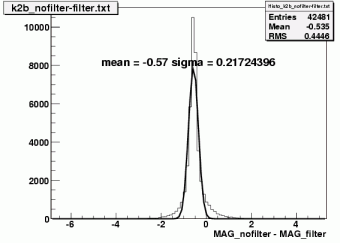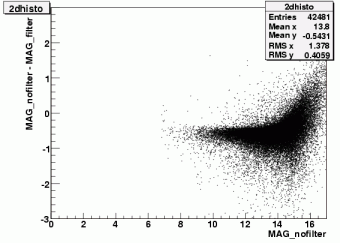Single frame k2b example (others look very similar) from MS analysis (5. 20060523):


The f=85 mm lenses with d=71 mm give (71/36)2 = 4 times more light than f=50 mm currently used in LCO.
The sky background is 4/(85/50)2 = 1.4 times higher
signal/sqrt(background) is 4/sqrt(1.4) = 4.7 times better
hence, the limiting magnitude is 1.7m fainter.
| 2006.05.20/21 | 2006.05.21/22 | |
| with filter | 92-111, 132-151 | 185-204, 225-244, 265-284 |
| no filter | 112-131, 152-171 | 165-184, 205-224, 245-264 |
First conclusions:
With this lenses stars have long tails. IR-cut filter reduces the tail by factor ~2.
This might meen that it is better to operate with the IR-cut filter in dense fields
and without the filter elsewhere.
Sky background in 400x400 central area is 1160 ADU (2515 e) with the filter and 2370 ADU (5139 e) without, i.e. the filter reduces the sky background by factor 2.0 .
Corresponding σ should be 50e and 72e respectively. Thus, we are clearly limited by the sky background. One shold not expect any improvement with stronge CCD cooling and only small improvement with summing up many images.
Study of Δm=mnofilter-mfilter
Single frame k2b example (others look very similar) from
MS analysis (5. 20060523):


|  | ||||||||||||||||||||||||
One can see, that the signal reduction by the filter (factor 1.75-1.90) is slightly smaller
than that of the backgroud (factor 2.0).
There is a tail of faint stars which are brigther with the filter.
I guess their are sitting on the bright star halos (see example image above).
The filter reduces the halo so the faint star looks brighter
(see the small peak at 115).
Coraz bardziej się skłaniam do konkluzji, żeby zostawić jedną kamerę z filtrem, a drugą bez.
To nie jest dobre dla systemu w LCO, ale mamy ważniejsze zadanie - zdecydować czy w pełnym pi dajemy filtry czy nie. Obawiam się, że nie będziemy na nie znać odpowiedzi przez pełną optymalizacją, gdyż te otoczki mogą wymagać sporych zmian. A tego nie zdążymy zrobić za mojego pobytu. Ale może jak zrobimy ten program testów to coś się wyjaśni ...